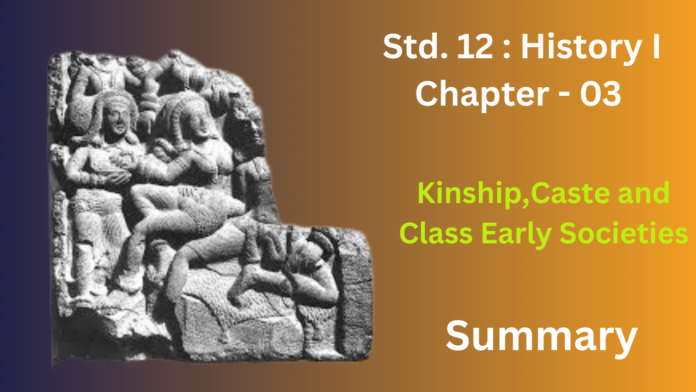“Kinship, Caste and Class: Early Societies” investigates Indian social history from roughly 600 BCE to 600 CE, using the Mahabharata to understand evolving social structures.It examines kinship systems, emphasizing lineage (patrilineage), marriage rules (endogamy/exogamy), and women’s varying status, and their impact on social organization and inheritance.A key focus is the emergence of caste, analyzing the varna theory and the reality of occupation-based jatis, rules of social interaction, marriage, and occupation, as well as untouchability. Finally, it explores the link between class and social status, examining how wealth (land ownership, trade) influenced social hierarchies and the lives of rulers, elites, commoners, and enslaved people.
Exercise
1. Explain why patriliny may have been particularly important among elite families.
Ans:
It facilitated the inheritance of resources and authority within the male line, preventing fragmentation of wealth and political control. For ruling families, patriliny established dynastic rule, providing stability and legitimacy through hereditary succession. It also ensured the continuity of hereditary ritual and religious roles within the male lineage. Furthermore, it enabled control over women’s sexuality and marriage to ensure legitimate male heirs and preserve family wealth and status through strategic alliances or endogamy. In essence, patriliny provided a stable framework for elite families to preserve their social, economic, and political dominance across generations.
2. Discuss whether kings in early states were invariably Kshatriyas .
Ans:
While the Dharmashastras theoretically designated Kshatriyas as rulers, historical evidence reveals deviations from this ideal. The origins of the Mauryas are uncertain, and the Shungas and Kanvas were Brahmanas. The Satavahanas asserted Brahmana identity while governing those considered Kshatriyas. Foreign rulers, such as the Shakas, existed outside the varna system altogether. Ultimately, the acquisition and maintenance of power frequently relied on support and available resources, rather than solely on Kshatriya lineage.
Therefore, despite Brahmanical prescriptions favoring Kshatriya kings, early Indian states witnessed rulers emerging from diverse social strata, indicating that kingship was not exclusively confined to the Kshatriya varna. The dynamics of power and prevailing social conditions often took precedence over the theoretical ideal.
3. Compare and contrast the dharma or norms mentioned in the stories of Drona, Hidimba and Matanga.
Ans:
Drona’s dharma, from the Mahabharata, shows a Brahmana adhering to Kshatriya duty but rigidly upholding caste hierarchy by denying Ekalavya and demanding his thumb. Hidimba, a Rakshasi in the Mahabharata, defies Rakshasa norms for love and loyalty to Bhima, challenging social boundaries. Matanga, from Buddhist texts, a Chandal, achieves enlightenment through merit, contradicting the birth-based Brahmanical dharma.
In essence, Drona’s dharma reflects a flexible yet hierarchical Brahmanical view, Hidimba’s prioritizes personal loyalty over social categories, and Matanga’s embodies a Buddhist perspective where dharma is based on merit, contrasting sharply with caste-based norms. These narratives reveal diverse and conflicting notions of social conduct in early Indian society.
4. In what ways was the Buddhist theory of a social contract different from the Brahmanical view of society derived from the Purusha sukta?
Ans:
The Brahmanical perspective on social organization, originating from the Purusha Sukta, asserts a divine genesis wherein the varnas arose from the primordial being Purusha, thus establishing a hierarchical system based on birth, with one’s dharma dictated by their varna.
It proposes that individuals collectively selected a leader to restore order from a state of societal decline, founded on mutual consent and human initiative. Kingship, according to this view, is a human construct designed to fulfill societal requirements, not a divinely sanctioned hierarchy. Furthermore, Buddhist doctrines emphasize karma and individual striving as determinants of one’s social standing in both present and future lives, offering a challenge to the birth-determined nature of the varna system.
Fundamentally, Brahmanism perceives society as divinely established and hierarchically structured by birth, whereas Buddhism views it as a human creation intended to maintain order, with individual actions holding greater significance than birth in determining social status.
5. The following is an excerpt from the Mahabharata, in which Yudhisthira, the eldest Pandava, speaks to Sanjaya, a messenger:
Sanjaya, convey my respectful greetings to all the Brahmanas and the chief priest of the house of Dhritarashtra. I bow respectfully to teacher Drona … I hold the feet of our preceptor Kripa … (and) the chief of the Kurus, the great Bhishma. I bow respectfully to the old king (Dhritarashtra). I greet and ask after the health of his son Duryodhana and his younger brother … Also greet all the young Kuru warriors who are our brothers, sons and grandsons … Greet above all him, who is to us like father and mother, the wise Vidura (born of a slave woman) … I bow to the elderly ladies who are known as our mothers. To those who are our wives you say this, “I hope they are well-protected”… Our daughters-inlaw born of good families and mothers of children greet on my behalf. Embrace for me those who are our daughters … The beautiful, fragrant, well-dressed courtesans of ours you should also greet. Greet the slave women and their children, greet the aged, the maimed (and) the helpless … Try and identify the criteria used to make this list – in terms of age, gender, kinship ties. Are there any other criteria? For each category, explain why they are placed in a particular position in the list.
Ans:
Yudhishthira’s order of greetings begins with Brahmanas and highly esteemed elders (Drona, Kripa, Bhishma), proceeds to royal family (Dhritarashtra), younger male kin (Duryodhana, warriors), and the greatly respected Vidura. Female relatives are addressed subsequently, differentiating between elder mothers, wives (noting their protection), daughters-in-law (acknowledging their families and motherhood), and daughters (with affection). The list concludes with courtesans, enslaved women and their children, and the vulnerable (aged, disabled, helpless), demonstrating a wide social consideration.
The criteria for this order include age (elders first), gender (males largely preceding females), familial connections (immediate family prioritized), social standing (Brahmanas highest, slaves lower), role/function (teachers, priests, warriors), and individual merit (Vidura’s wisdom). The arrangement reflects the hierarchical societal norms and familial bonds of that era, with the most honored and senior individuals greeted first, followed by relatives based on age and generation, and finally extending to those outside the immediate family according to their social position and vulnerability.
6. This is what a famous historian of Indian literature, Maurice Winternitz, wrote about the Mahabharata: “just because the Mahabharata represents more of an entire literature … and contains so much and so many kinds of things, … (it) gives(s) us an insight into the most profound depths of the soul of the Indian folk.” Discuss.
Ans:
Maurice Winternitz emphasizes the Mahabharata’s encyclopedic quality, asserting that its extensive scope and varied content provide profound insight into the Indian psyche. Rather than a singular tale, it encompasses diverse narratives, myths, philosophical discussions, ethical and legal principles, and social customs of ancient India. This multifaceted portrayal, featuring intricate characters confronting universal human issues within a specific cultural framework, deeply resonates with the “soul of the Indian folk.”
The epic explores core concepts like dharma, karma, duty, righteousness, and the consequences of actions, themes that have significantly shaped Indian thought and continue to influence cultural values. Its flawed yet virtuous characters embody human complexity, fostering cross-generational relatability. The inclusion of varied social groups and perspectives, though through an epic lens, offers glimpses into the social fabric of the era. The Mahabharata’s enduring popularity and repeated retellings across India’s diverse linguistic and regional landscape underscore its deep connection to the collective consciousness and its capacity to articulate fundamental cultural values and beliefs. Ultimately, its very comprehensiveness allows it to tap into foundational narratives and moral frameworks defining a significant aspect of Indian identity.
7. Discuss whether the Mahabharata could have been the work of a single author.
Ans:
The established scholarly view is that the Mahabharata was not written by a single author due to its vast length (over 100,000 verses), diverse literary styles and philosophies, and clear evidence of additions over centuries, indicating compilation by multiple authors or bards.
Supporting factors include internal inconsistencies and contradictions in narratives and philosophies, suggesting multiple perspectives. Multiple layers of composition, evidenced by linguistic analysis and textual evolution, show earlier core stories with later didactic and philosophical additions. Varied literary styles across sections point to different writers. The epic likely originated as oral traditions passed down by bards and gradually compiled and expanded. The geographical and cultural diversity reflected suggests contributions from individuals with varied regional knowledge.
While Vyasa is traditionally credited, scholars see him more as a compiler or central figure for coalescing traditions rather than a sole author. The Mahabharata is best understood as an encyclopedic work that grew organically through collective authorship and continuous additions over centuries.
8. How important were gender differences in early societies? Give reasons for your answer.
Ans:
Gender differences were fundamental in early societies, shaping nearly all aspects of life. A division of labor typically assigned men to roles outside the home (hunting, warfare) and women to domestic tasks (childcare, household), structuring economic and social roles. Kinship and inheritance systems, often patrilineal, emphasized male heirs for lineage and property, with women’s roles centered on marriage and reproduction. Men generally held greater social status and power, with women having limited access to public life. Control over resources and women’s sexuality was often vested in men to maintain social order. Deeply ingrained cultural norms and expectations dictated gender-appropriate behavior. In essence, gender differences were socially constructed and reinforced, playing a crucial role in organizing labor, structuring kinship, distributing power, and shaping social identities, making them a foundational element of early societal function.
9. Discuss the evidence that suggests that Brahmanical prescriptions about kinship and marriage were not universally followed.
Ans:
Several pieces of evidence indicate that Brahmanical rules concerning kinship and marriage were not universally observed in early Indian societies. Satavahana kings using metronymics showed women retaining their natal lineage, contrary to the expectation of adopting their husband’s gotra. The Satavahanas’ practice of endogamy and polygamy also deviated from the Brahmanical ideals of exogamy and monogamy. The Mahabharata’s narrative of Draupadi’s polyandry, despite attempts at justification, suggests the existence of alternative marital customs. The Manusmriti’s acknowledgment of eight marriage forms, including those not sanctioned by Brahmanical norms, points to the acceptance of diverse social practices. Instances of inter-caste marriages, such as the Satavahanas’ alliances with Shaka families, further illustrate this divergence. Finally, regional variations, like cross-cousin marriage in South India, directly contradicted Brahmanical prohibitions. These examples collectively demonstrate that while Brahmanical prescriptions were influential, they were not the sole or universally accepted norms across all communities and regions in early India, with diverse social customs and regional traditions often differing from these idealized rules.


